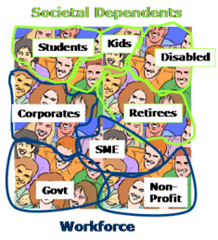An HR Carnival on Corporate Social Responsibility, how could we resist? Organizations cannot distance themselves from the social issues that define both the communities they serve and the communities from which they source their employees, and this is becoming an increasing imperative where talent is short.
The image at left is a high level map of workforce vs dependents in society, and of course in an aging society the proportion of dependents to workforce is higher - which can present serious social challenge. While keeping people in the workforce forever is not an option (we hope!), looking for groups who have relatively low participation (such as the disabled in some countries, women in others, parents in still more), and crafting value propositions which make it worth their while, organizations can individually impact participation.
But to identify which groups are the best to target, we use the structured process of Strategic Workforce Planning. Workforce Planning can impact:
- The number of dependents
- The role of dependents
- The level of dependency
Organizations that Workforce Plan can influence social and economic agendas. Whether that is by World Vision influencing the language and other skills available in the many countries they serve; Aetna developing programs which increase the value of returning to work in the retired; or any of the multiple other diversity, inclusion and participation initiatives that can come out of good workforce planning, it really does make a difference - and has a strong impact on our Corporate Social Responsibility!
Oh, and one of our clients includes their workforce planning activities in their CSR report. Do you?
Labels: Demographics, What IS Strategic Workforce Planning?, Workforce Planning Techniques, Working Parents

Post a Comment